 Your new post is loading...
 Your new post is loading...
In September of 2013, the late David Carr, skeptical of the burgeoning native advertising tactic that was back then “all the rage,” wrote a column titled “Storytelling Ads May Be Journalism’s New Peril.” Three months later, the Times jumped into the fray. Today the company boasts a fully-fledged content marketing arm, T Brand Studio. Adam Aston, vice president and executive editorial director of the Studio, said when it was first launched, there was a sense of anxiety among the Times’ newsroom, as well as advertisers, that the content they created wouldn’t be up to par with its editorial content. “We were really mindful from inception to approach it as fact-first, narrative-first, with a strong story, strong characters,” he said at a recent panel event, hosted by MediaRadar in New York City, about the future of native advertising. “From inception, whether we were making the simplest stories we could three or four years ago, to today, where a lot of what we’re making is a three-ring circus of interactivity, like VR and AR, we’re still driven by the same thought that the story, the quality of the reporting, finding authentic people, much in the way that our newsroom inspires readers – we want to do the same thing.” Here are five tips from the panelists for using native advertising....
Therefore, content creators and advertisers may find themselves scratching their heads about how to break through the clutter with compelling branded content that attracts an audience and makes them want more. “While there’s no ‘one size fits all’ when it comes to creating impactful branded content, we’ve identified some common themes in our research and content testing that can be used as best practices for making content resonate with audiences,” said Harry Brisson, Director of Lab Research at Nielsen. To better understand how consumers are reacting to this new form of marketing content, Nielsen assessed consumer reactions to more than 100 pieces of branded content and found that a brand’s effectiveness (e.g., how a brand resonates with viewers) is largely affected by the format and environment the message is delivered in. The results of the analysis uncovered three key takeaways that can help brands deliver strong content that resonates with and builds audiences: - Branded content can drive higher brand recall and brand lift than pre-roll - When viewers enjoy content, they view the integrated brands more favorably - Partnering with a publisher can drive ad impact....
Like most news publications, the 14 organizations that participated in a recent study of native advertising label the content to distinguish it from their independent editorial content. They said they were well aware of the need to maintain audience trust in the crowded news and information market.
However, in general, the use of the same storytelling conventions and formats as news in sponsored content has prompted user confusion and drawn the attention of the Federal Trade Commission.
The 14 publications that participated in "The Rise of Sponsored Content in Digital News Publications," a study I produced for the Tow-Knight Center for Entrepreneurial Journalism at City University of New York, maintained that native ads done well aren’t necessarily deceptive or even unwelcome. The key they said, is to provide engaging content that is relevant to the audience and to generally avoid making direct sales pitches.
“I don’t think anybody objects to native advertising. People just object to bad advertising,” said Sebastian Tomich, Senior Vice President Advertising & Innovation at The New York Times. “It comes down to quality, user experience and quality.”...
Most online publishers use some form of native advertising — ads that look like news stories — to grow revenue. It is accepted practice to declare that this content is sponsored by a company, so that readers can differentiate between what is and is not news. However, the way in which many publishers declare these ads could be "complicit with deception," according to a new study by Bart Wojdynski, director of the digital media, attention, and cognition lab at the University of Georgia.Wojdynski and Nathaniel J. Evans, assistant professor in advertising at the same university, led the study, which found that 60% of readers did not notice the sponsor disclosure label placed at the top of sponsored articles. It also showed that readers are seven times more likely to recognize the labels that use some form of the words "advertising" or “sponsored,” than those which use more vague phrases like “brand voice” or “presented by.” Overall, only 20% of people in the study were aware that they were reading advertising, rather than objective, editorial content....
Therein lies the problem: native advertising is more effective because it masquerades as actual content. But it’s illegal to pass advertising messages off as editorial content. The Advertising Standards Authority in the United Kingdom, for instance, banned a native YouTube ad sponsored by Oreo that featured two well known video bloggers because the agency felt it was not clearly identified as marketing communication.
Stateside, the Federal Trade Commission (“FTC”) has long waged war on false advertising—marketing or advertising communications that tend to mislead consumers. Recently, the FTC issued an “enforcement policy statement on deceptively formatted advertisements” giving advertisers and publishers alike a heads up: deceptive native ads will not be tolerated.
So how can your brand capitalize on native advertising without breaking the law? The FTC offers some insight in their guide, “Native Advertising: A Guide for Businesses.”...
Eagle-eyed readers may notice a new feature here on Re/code today. It’s called “Sponsor Content,” and is, for us, a new form of advertising. Known broadly as “native advertising,” this is a category of ad that takes the form of an article written by, or commissioned by, an advertiser. It’s widely used online, but the technique actually goes back well before the Web, when print publications ran articles written by advertisers that were called “advertorials.”
Some websites might try to present these ads as if they were normal posts written by their reporters, editors, or curated guest contributors. We won’t be doing that. You’ll notice that we clearly label them “Sponsor Content” with a blue label instead of our usual black one. We also use the company logo next to the writer’s byline, and, at the bottom of each such post, include a disclosure statement saying that the article is a form of advertising, and was neither written by, nor edited by, our journalists.
That doesn’t mean these pieces are bad, or unworthy of your time. It doesn’t mean we are embarrassed to post them. In fact, we hope you will find them interesting. It just means we want to keep faith with you by making things clear.
|
The nonprofit Online Trust Alliance (OTA) on Wednesday conducted a study that found 71% of native ads on top media sites fail to offer adequate labeling, transparency, and complete consumer disclosure.
This is a blow to the native ad/branded content business and should be a wake-up call for publishers and content studios.
The study, an analysis of native ads on the top 100 news websites, found that 71% earned failing scores for disclosures, delineation, and discoverability. The bottom line: The sites didn’t offer consumers the ability to easily discern pure editorial from ads.
As most readers of this column know, native advertising refers to Web site content that’s funded and produced outside the publisher’s editorial review or influence, yet is designed to appear similar to editorial on that site. As the OTA mentions, “this illustrates the tension -- paid for and controlled separately, but presented in a way to appear as editorial. The potential for audience confusion or misinterpretation is obvious, and the rapid rise in the deployment of native has already prompted concerns from advocates, media and regulators.”...
“While the industry looks at native advertising as the holy grail to drive new revenues, they are failing to address the long-term issue. With 71% of native ads failing to pass the consumer transparency acid test, this report should be a wake-up call to the industry. Inaction is not an option. Conversely, providing these concrete examples and recommendations helps advertisers, networks and publishers in moving forward,” Craig Spiezle, executive director at the Online Trust Alliance, told Native Insider via email.
Native Insider: Part of the challenge with "native" is that each organization has a different understanding of what it is. For the purposes of the research, what is your definition of native advertising?
Wu: In our study, we defined native advertising as sponsored content, which features content that is similar and consistent with publishers’ content and is often consumed by readers like non-sponsored content. I agree that there are also other types of native advertising, such as sponsored social media posts or sponsored hyperlinks. We focused on sponsored content because it is widely adopted by many news organizations, including very reputable ones like The New York Times.
Native Insider: Your research found that when content was identified as native advertising, readers expressed a lower opinion of the media outlet it was published in. However, the reputation of the company being promoted was not affected. Can you elaborate on this finding?
Wu: I think this was one of the most interesting findings in our study. We originally expected that both companies and media outlets would be negatively influenced. However, the media outlet was the only source that was affected. On one hand, this indicates that readers are not surprised by the sponsored content from a company, since similar covert marketing techniques have been utilized before, such as video news releases....
Gupta sees the market evolving in a bifurcated way: premium native vs. programmatic native. He sees premium native as branded content and maintains that programmatic native is much closer to display advertising. While there’s a lot of excitement around programmatic native from the ad tech community, Gupta takes the contrarian view that native is premium content created by publishers -- and publishers alone. That’s in contrast to programmatic native, which is created by advertisers.
Gupta’s purist view is that premium native is focused on quality content and engagement, while programmatic native is focused on getting an audience at the lowest possible price. Further, “Publishers are starting to see that programmatic native is different than programmatic display,” Gupta says. “They’ve seen how programmatic display has eroded the value of their premium display business.”
Gupta says that while some premium publishers work with Outbrain and Taboola, they’re rethinking working with these partners because of a poor user experience and click bait. In addition, he says that programmatic native doesn’t offer a way to optimize for engagement. Gupta argues that if you’re a marketer and you buy ads on Outbrain and Sharethrough, you don’t know where those ads are going to run....
The underlying reason? Today’s shoppers are skeptic of pure play tactics. They see value in connecting and acquiring rather than reliance on a brand’s library of products. As a result, they are looking for shopping destinations or inspirational sites.
Perhaps that’s why brands are agog over social commerce.
For those unaware, it is the concept of utilizing social networks to increase sales transactions. Actionable marketing expert Heidi Cohen defines it as the maturation and evolution of social media meets shopping....
Those 11 inspiring videos are all original feel-good New York Times productions, and as Digiday’s Lucia Moses noted this morning, the ad is intended to drive subscription signups forThe Times, with a prominent call to action at the top of the piece imploring readers to “Get with The Times.
”While this may seem bizarre and a little too meta for this early in the morning, it’s actually a shrewd move by The Times to grow their audience. Clearly, they’ve identified Mashable readers as potential Times readers and subscribers, and as a result, they’ve come to them with a month-long campaign of branded posts._
The Times also punched up the titles of the individual videos for a Mashable audience. “Tattoo Artist Gives Breast Cancer Survivors Nipples and Hope” was originally titled “The Nipple Artist,” and “Can Your Grandma Pump Iron Like This?” was called “Shirley and the Bodybuilder.”...
|



 Your new post is loading...
Your new post is loading...

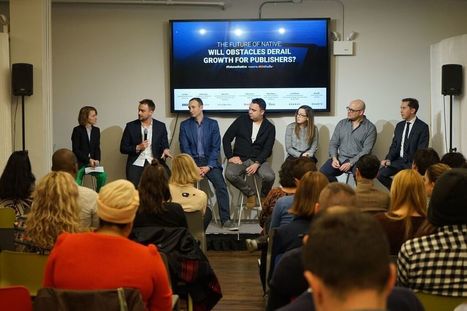





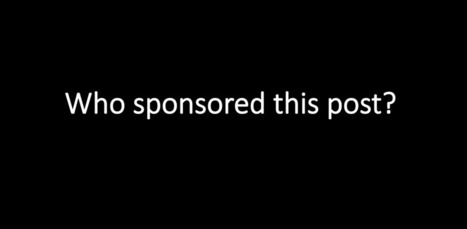

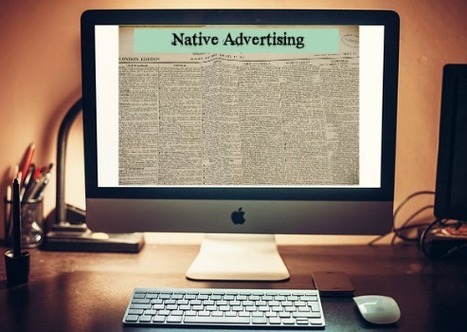
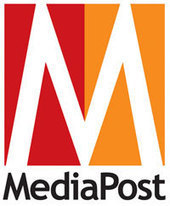





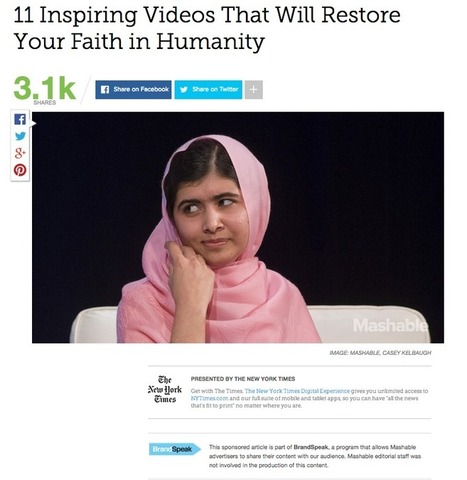





The secret to success in native advertising? Quality!